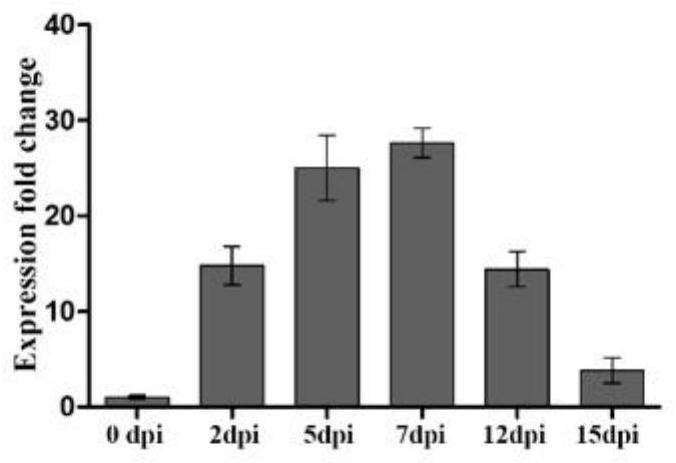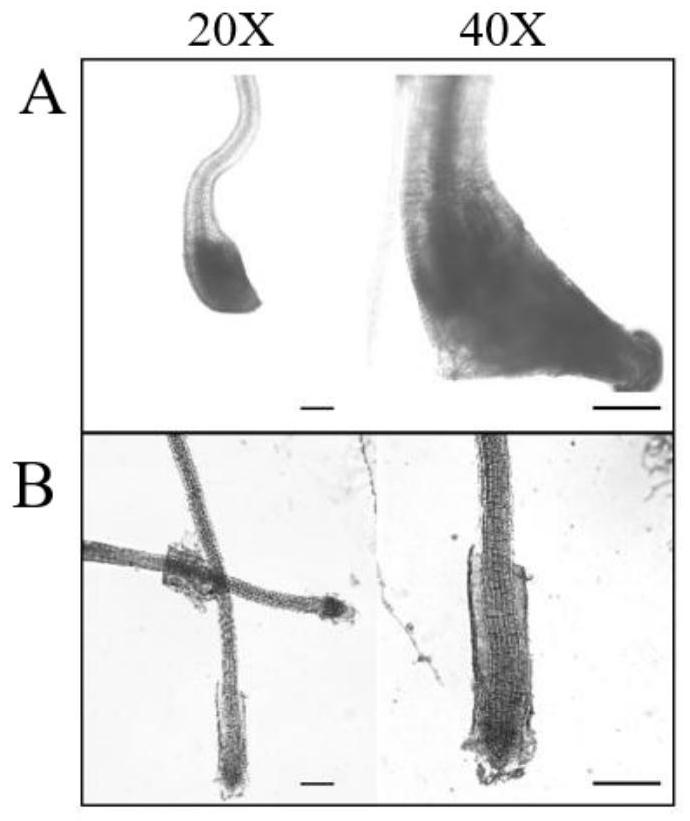Application of OsHin1 gene in prevention and control of gramineous meloidogyne
A root-knot nematode and genetic technology, applied in the fields of application, genetic engineering, plant genetic improvement, etc., can solve the problems of short life cycle, difficult prevention and control, etc., and achieve the effect of broad application prospects
- Summary
- Abstract
- Description
- Claims
- Application Information
AI Technical Summary
Problems solved by technology
Method used
Image
Examples
Embodiment 1
[0027] Example 1 Recognition of rice OsHin1 gene to nematode infestation
[0028] 1. Rice Culture and Nematode Inoculation
[0029] Wild-type Nipponbare rice grown for 2 weeks was taken, and each plant was inoculated with 200 root-knot nematodes of Gramineae, and rice roots not inoculated with nematodes were used as a negative control. The rice culture conditions are: temperature 28°C, light / dark cycle 16h / 8h.
[0030] 2. Rice total RNA extraction and cDNA synthesis
[0031] Nipponbare rice roots of each group were taken at different periods after inoculation, and total RNA was extracted.
[0032] The total RNA of rice was obtained using the RNAprep pure Plant Kit method, and the specific steps were as follows:
[0033] (1) Take 100 mg Nipponbare rice root and quickly grind it into powder in a mortar filled with liquid nitrogen, then transfer it to 450 μL RL solution (1% β-mercaptoethanol), and shake vigorously.
[0034] (2) Transfer the lysate to a CS filter column and ce...
Embodiment 2
[0052] Cloning and vector construction of embodiment 2 rice OsHin1 gene
[0053] 1. Cloning of OsHin1 gene
[0054] The reference for obtaining the rice cDNA is the same as in Example 1.
[0055] The full-length cDNA sequence of the OsHin1 gene contains a 675bp open reading frame (SEQ ID NO: 1), encoding 224AA (SEQ ID NO: 2).
[0056] Using rice cDNA as a template, the OsHin1 gene was amplified by the following specific primers:
[0057] OsHin1-BamH1-F: ATGAGCAAGGAGAAGCAC;
[0058] OsHin1-Pst1-R: CACCTCGACGCTGCACCC.
[0059] 2. Vector construction of OsHin1 gene
[0060] The 35s promoter in pCAMBIA1305 was replaced with the maize ubiquitin promoter Ubi by double enzyme digestion to obtain the pCAMBIA1305:Ubi rice expression vector. The OsHin1 fragment containing the BamH1 / Pst1 restriction site amplified in step 1 is connected into the pCAMBIA1305:Ubi expression vector to obtain the overexpression vector pCAMBIA1305.1:Ubi:OsHin1( image 3 ).
[0061] Mutation targets CAA...
Embodiment 3
[0062] Example 3 Rice OsHin1 Gene Overexpression and Transformation of Mutant Plants
[0063] The wild-type Nipponbare rice callus was transformed by carrying the overexpression vector of Example 2 and the gene knockout vector in Agrobacterium, respectively.
[0064] After antibiotics and PCR screening, 12 rice positive transformed plants with OsHin1 gene mutation and 25 rice positive transformed plants with OsHin1 gene overexpressed were obtained.
[0065] Sequencing analysis was performed on the OsHin1 gene knockout lines, and three homozygous lines were obtained for later experiments ( Figure 6 ). At the same time, qRT-PCR checks the transcription of the OsHin1 gene in the mutant rice, and the results are shown in the figure Figure 7 As shown in A.
[0066] Finally, through qRT-PCR analysis, three overexpressed plants with higher OsHin1 gene expression were selected for later experiments ( Figure 8 A).
PUM
 Login to view more
Login to view more Abstract
Description
Claims
Application Information
 Login to view more
Login to view more - R&D Engineer
- R&D Manager
- IP Professional
- Industry Leading Data Capabilities
- Powerful AI technology
- Patent DNA Extraction
Browse by: Latest US Patents, China's latest patents, Technical Efficacy Thesaurus, Application Domain, Technology Topic.
© 2024 PatSnap. All rights reserved.Legal|Privacy policy|Modern Slavery Act Transparency Statement|Sitemap



